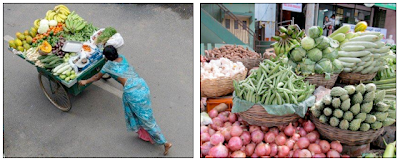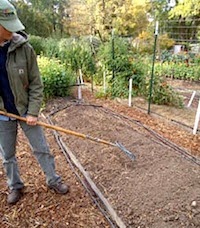by Mila van de Sande
Assistant Trial Gardener
I am the Assistant Trial Gardener at the Renee’s Garden California Trial Gardens, where I work ten months of each year, taking a two month break each winter when it is miserably cold and wet here and the trial gardens need less attention. I take advantage of my time off to travel to faraway warm places. (I inherited the travel bug from my parents and my grandparents.)
In the last few years, I’ve spent my garden break time traveling to Mexico, South Africa, and India. Everywhere my travels take me, I love finding local farmers markets to see what they have to offer and how they display their goods. It is especially fun to see what unusual fruits and vegetables are available and sample them too.
 |
| Boarding the train in India Zapotec Ruins in Oaxaca |
I spent a month in Oaxaca, Mexico in 2008 taking language classes and we made a point of exploring the different markets. The markets I went to were very extensive and sold a bit of everything you might need from all kinds of food, including live turkeys, to fabric and household items like mops. There were rows and rows of fruits and vegetables, including big sacks of dried chilies, dried hibiscus, and a beautiful array of many dried bean varieties, one of my favorites.
There were pails with towers of oranges and bundles of onions with their greens still attached. One market I also went to was a small all Organic market with fruit, vegetable, and prepared food stands. This was not an abundant market, but it was good to see an Organic option. We had a lot of fun exploring all these colorful markets.
 |
| Oaxaca: Dried chiles and hibiscus Dried beans |
My next trip was to Chiapas, Mexico. One of the farmers markets I went to there was in the town square of a small village outside of the city, with many vendors offering towers of colorful fruits and vegetables. Other vendors were selling their wares simply spread out on clothes on the ground.
One of the vegetables there that I was less familiar with was chayotes. They are related to squash and grow on a large vining plant. The big pear-shaped fruits are used like summer squash. We also visited a smaller Organic market in the city, which was teaming with beautiful vegetables, edible flowers, prepared food, baked goods, and honey.
 |
| Chiapas: Edible flowers & vegetables Chayotes and zucchini |
My next year’s adventure took me to South Africa. In preparation for a week-long self-guided safari in northeastern South Africa with my mother, we went to a farmers market in Johannesburg to stock up on veggies. The market consisted of fruit and vegetable stands, prepared food, vegetable starts, and a wide range of crafts; one vendor was selling heirloom seeds along with vegetable starts.
One thing that stood out to me were the big beautiful pumpkins of various shapes and sizes. These are among my favorites, so we bought a yummy big blue one that we ate and enjoyed all week long.
 |
| Johannesburg: Veggie starts Vegetable stand |
In 2011, along with my friends Trial Garden Manager Lindsay and Josie, I went to India for my winter getaway. My experience of markets in India was different. In Bangalore, a city in the south, stands were set up in the street between the lane of cars and the sidewalk. These stands held a plethora of interesting and beautiful fruits, vegetables, and herbs, many of which I had never seen before.
,+Mila(Assist.+Gardener),+Josie(former+Renee%27s+gardener)Rajasthan,+India.jpg) |
| Lindsay, Mila and Josie in Rajasthan, India |
There were bread fruits, curry leaves, bananas of different sizes, dragon fruits, and summer squashes of many different colors and textures, just to name a few. I got to try some of these unusual fruits and vegetables while staying at my friend’s parent’s house; some I loved and others I found more interesting than delicious.
Another kind of “market” in Bangalore were the fruit and vegetable vendors that travel the streets with carts selling their goods. They call out what they are selling and will come to your front door if you ask them over. These vendors were a wonderful feature of that city.
 |
| India: Traveling vendor Vegetable Stand |
I have had great fun going visit markets in different parts of the world. Where will my next adventure take me? I am not sure, but I am hoping to do more traveling in South America, where I can continue to discover what their markets and culture have to offer.














,+Mila(Assist.+Gardener),+Josie(former+Renee%27s+gardener)Rajasthan,+India.jpg)

























